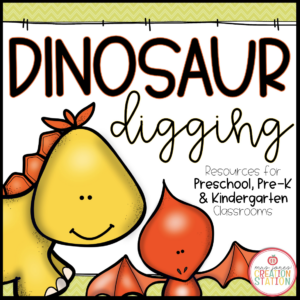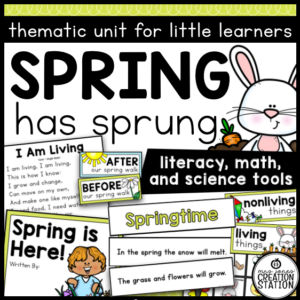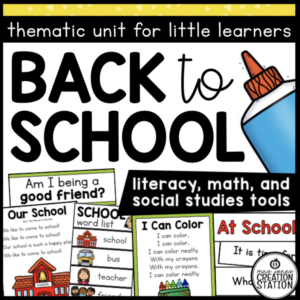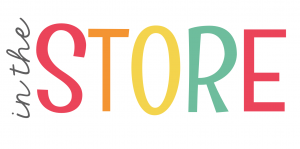POLAR ANIMALS THEME ACTIVITIES
It’s winter and time to learn all about polar animals! This science based unit ties science, math and literacy together and provides you with tons of activities about polar animals for an entire week of instruction!
Use the detailed lesson plans to guide you through five days of polar animals lessons and activities. A list of preferred picture books is included to tie in with each activity. Your learners will explore facts about polar bears and penguins. They will get to see what blubber does up close and can create their own polar animal!
Add the polar animals themed literacy and math centers to your plans to guarantee student engagement while you’re teaching in small groups.
Buy the BUNDLE and SAVE! You can purchase this resources in the Thematic Activities for Little Learners Bundle and the Little Learners Mega-Bundle!
Here is what you’ll get:
-Detailed lesson plans
-A list of picture books to use during your whole group lessons (books not included)
-Shared writing and reading activities
-Writing center activities
-Polar animals themed interactive poem
-Five days of polar animals whole group activities
-Polar animals themed literacy and math centers
**To see a more details of this resource, check out this resource’s preview!
⭐⭐⭐⭐⭐ What Teachers Are Saying:
“We used these during the week before Christmas to study polar animals, we printed off the picture cards of the polar animals and we used them on the word board. The kids loved looking at them throughout the day. We laminated them and placed them in our science center for the kids to use a resources.” –Ansley L.
“My students loved using this resource during different parts of our day. This resource helped with their fascination with polar animals. It was simple to prepare. Thank you so much!” –Kelly J.
“Just what I was looking for to add to our polar animals unit. Thank you!” –Margaret J.
YOU MIGHT ALSO LIKE:
WINTER THEMATIC UNIT
WINTER ANIMALS THEMATIC UNIT
PENGUIN SCIENCE LAPBOOK
LEARNING STANDARDS INCLUDED IN THIS RESOURCE
Common Core Standards
Language Arts
CCSSL.K.1a
Print many upper- and lowercase letters.
CCSSL.K.5a
Sort common objects into categories (e.g., shapes, foods) to gain a sense of the concepts the categories represent.
CCSSRF.K.1c
Understand that words are separated by spaces in print.
CCSSRF.K.1d
Recognize and name all upper- and lowercase letters of the alphabet.
CCSSRF.K.2b
Count, pronounce, blend, and segment syllables in spoken words.
CCSSRF.K.3c
Read common high-frequency words by sight (e.g., the, of, to, you, she, my, is, are, do, does).
CCSSRF.K.4
Read emergent-reader texts with purpose and understanding.
CCSSRI.K.3
With prompting and support, describe the connection between two individuals, events, ideas, or pieces of information in a text.
CCSSRI.K.7
With prompting and support, describe the relationship between illustrations and the text in which they appear (e.g., what person, place, thing, or idea in the text an illustration depicts).
CCSSRI.K.9
With prompting and support, identify basic similarities in and differences between two texts on the same topic (e.g., in illustrations, descriptions, or procedures).
CCSSRL.K.7
With prompting and support, describe the relationship between illustrations and the story in which they appear (e.g., what moment in a story an illustration depicts).
CCSSW.K.2
Use a combination of drawing, dictating, and writing to compose informative/explanatory texts in which they name what they are writing about and supply some information about the topic.
Math
CCSSK.CC.A.3
Write numbers from 0 to 20. Represent a number of objects with a written numeral 0-20 (with 0 representing a count of no objects).
CCSSK.CC.B.4
Understand the relationship between numbers and quantities; connect counting to cardinality.
CCSSK.G.A.2
Correctly name shapes regardless of their orientations or overall size.
Next Generation Science Standards
NGSSK-LS1-1
Use observations to describe patterns of what plants and animals (including humans) need to survive. Examples of patterns could include that animals need to take in food but plants do not; the different kinds of food needed by different types of animals; the requirement of plants to have light; and, that all living things need water.
NGSSK-ESS2-2
Construct an argument supported by evidence for how plants and animals (including humans) can change the environment to meet their needs. Examples of plants and animals changing their environment could include a squirrel digs in the ground to hide its food and tree roots can break concrete.
Texas Essential of Knowledge and Skills
Language Arts
TEKSLA.K.2.A.i
Developing and sustaining foundational language skills: listening, speaking, reading, writing, and thinking–beginning reading and writing…The student is expected to: demonstrate phonological awareness by: identifying and producing rhyming words.
TEKSLA.K.2.B.ii
Developing and sustaining foundational language skills: listening, speaking, reading, writing, and thinking–beginning reading and writing…The student expects to: demonstrate and apply phonetic knowledge by: using letter-sound relationships to decode, including VC, CVC, CCVC, and CVCC words.
TEKSLA.K.2.E
Developing and sustaining foundational language skills: listening, speaking, reading, writing, and thinking–beginning reading and writing…The student expects to: develop handwriting by accurately forming all uppercase and lowercase letters using appropriate directionality.
TEKSLA.K.3.C
Developing and sustaining foundational language skills: listening, speaking, reading, writing, and thinking–vocabulary…The student expects to: identify and use words that name actions; directions; positions; sequences; categories such as colors, shapes, and textures; and locations.
TEKSLA.K.5.H
Comprehension skills: listening, speaking, reading, writing, and thinking using multiple texts. The student uses metacognitive skills to both develop and deepen comprehension of increasingly complex texts. The student expects to: synthesize information to create new understanding with adult assistance.
TEKSLA.K.5.I
Comprehension skills: listening, speaking, reading, writing, and thinking using multiple texts…The student expects to: monitor comprehension and make adjustments such as re-reading, using background knowledge, checking for visual cues, and asking questions when understanding breaks down with adult assistance.
TEKSLA.K.6.B
Response skills: listening, speaking, reading, writing, and thinking using multiple texts. The student responds to an increasingly challenging variety of sources that are read, heard, or viewed. The student expects to: provide an oral, pictorial, or written response to a text;
TEKSLA.K.6.F
Response skills: listening, speaking, reading, writing, and thinking using multiple texts. The student responds to an increasingly challenging variety of sources that are read, heard, or viewed. The student expects to: respond using newly acquired vocabulary as appropriate.
Math
TEKSMA.K.2.A
Number and operations. The student applies mathematical process standards to understand how to represent and compare whole numbers, the relative position and magnitude of whole numbers, and relationships within the numeration system. The student is expected to: count forward and backward to at least 20 with and without objects.
TEKSMA.K.2.B
Number and operations. The student applies mathematical process standards to understand how to represent and compare whole numbers, the relative position and magnitude of whole numbers, and relationships within the numeration system. The student expects to: read, write, and represent whole numbers from 0 to at least 20 with and without objects or pictures,
TEKSMA.K.2.C
Number and operations. The student applies mathematical process standards to understand how to represent and compare whole numbers, the relative position and magnitude of whole numbers, and relationships within the numeration system. The student expects to: count a set of objects up to at least 20 and demonstrate that the last number said tells the number of objects in the set regardless of their arrangement or order.
TEKSMA.K.6.A
Geometry and measurement. The student applies mathematical process standards to analyze attributes of two-dimensional shapes and three-dimensional solids to develop generalizations about their properties. The student expects to: identify two-dimensional shapes, including circles, triangles, rectangles, and squares as special rectangles.
TEKSMA.K.6.D
Geometry and measurement. The student applies mathematical process standards to analyze attributes of two-dimensional shapes and three-dimensional solids to develop generalizations about their properties. The student expects to: identify attributes of two-dimensional shapes using informal and formal geometric language interchangeably.
Science
TEKSSCI.K.9.A
Organisms and environments. The student knows that plants and animals have basic needs and depend on the living and nonliving things around them for survival. The student is expected to: differentiate between living and nonliving things based upon whether they have basic needs and produce offspring
TEKSSCI.K.9.B
Organisms and environments. The student knows that plants and animals have basic needs and depend on the living and nonliving things around them for survival. The student is expected to: examine evidence that living organisms have basic needs such as food, water, and shelter for animals and air, water, nutrients, sunlight, and space for plants
TEKSSCI.K.10.A
Organisms and environments. The student knows that organisms resemble their parents and have structures and processes that help them survive within their environments. The student is expected to: sort plants and animals into groups based on physical characteristics such as color, size, body covering, or leaf shape;
TEKSSCI.K.10.B
Organisms and environments. The student knows that organisms resemble their parents and have structures and processes that help them survive within their environments. The student is expected to: identify basic parts of plants and animals;
CONNECT WITH MJCS
WEBSITE | FACEBOOK | INSTAGRAM | PINTEREST | TEACHERS PAY TEACHERS
© Mrs. Jones’ Creation Station, Inc




